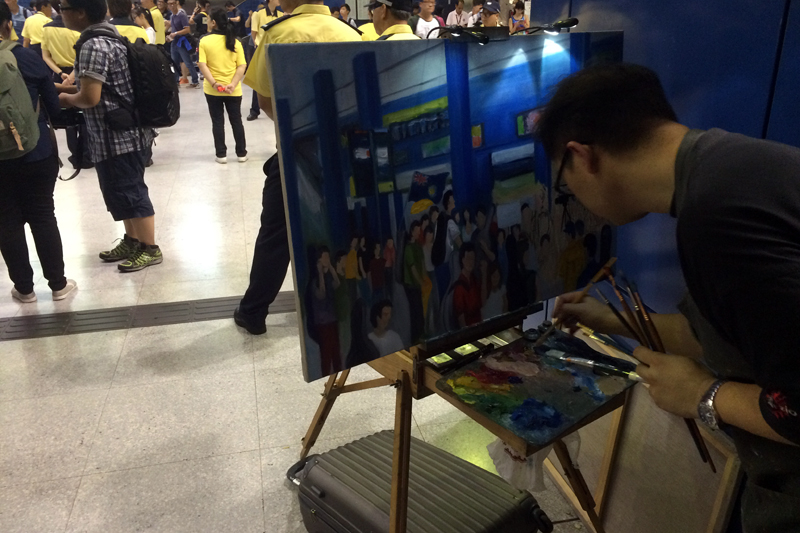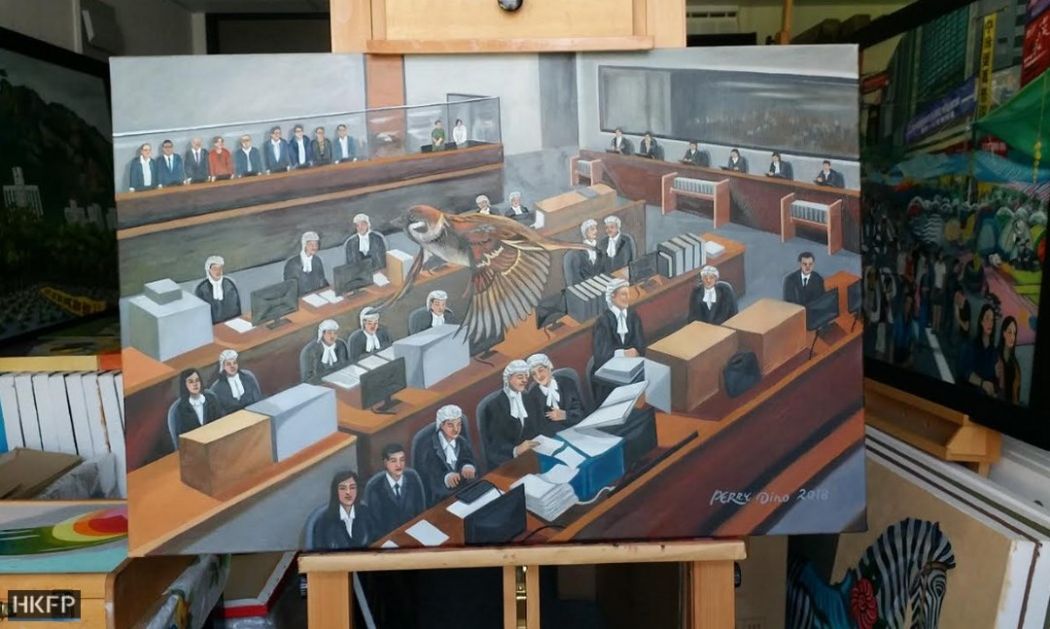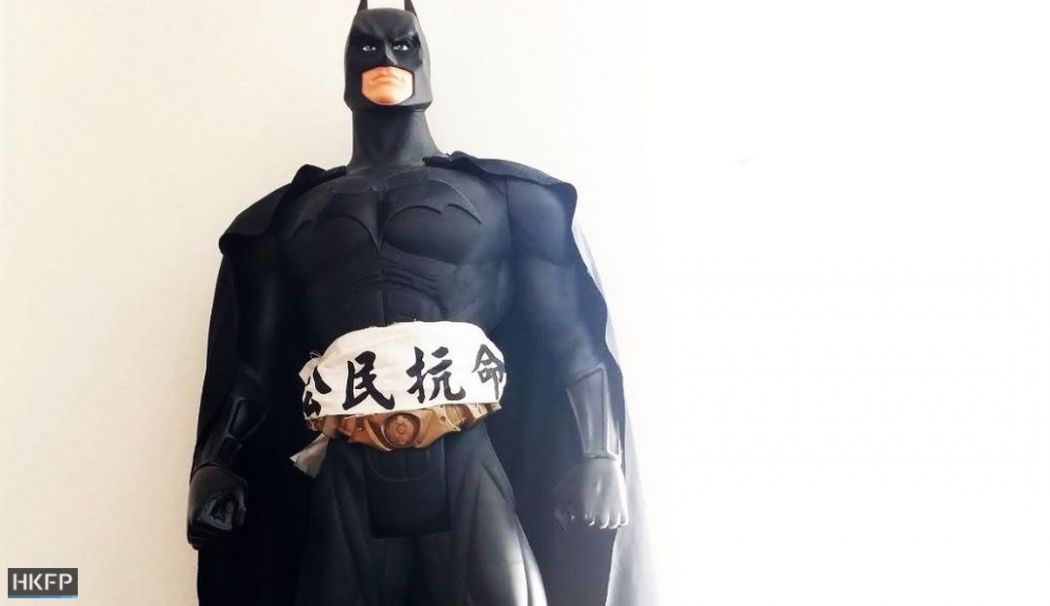It is not unusual for Hongkongers who were alive in 1989 to remember vividly what it was they were doing on June 4th that year. Artist Perry Dino, known for his prolific protest painting, is no exception.
As he recalls this memory, he is sat among stacks of works in oil. His modest studio is in an industrial district of Hong Kong favoured by artists who need to save on rent.

Outside his window, a crisp blue sky offers natural light to a stifling space filled with teddy bears, CDs, easels, and almost a dozen guitar cases. Dino, who admits he is not the most practical of people, needs to keep that window ajar lest he chokes on paint fumes.
He is not all that practical, but he is quite musical. A keen self-taught musician, Dino’s collection of instruments includes more than 20 guitars, alongside a saxophone, a flute, a cello and violin.
The size of that collection is something he does not like to admit to his wife, an art teacher with whom he lives alongside their two children and an Australian cockatoo in a public housing estate in Kowloon.
Here, in his studio, his CD collection spans two shelves devoted to an array of genres, from jazz and classical to pop, excluding only rap music.
Music obviously is a huge source of inspiration for Dino, whose lesser-known works include a series of portraits of John Lennon.
“He is my hero,” says Dino.

When he talks about Lennon, his face takes on a brightness that disappears as topics turn darker, and as Dino reflects on his political engagement through the years in the shifting space for expression in his native Hong Kong.
Sat in front of that window next to his latest work – a court scene involving the nine Occupy ringleaders on trial – Dino chats in long, at times disjointed, but always piercingly sincere passages.
“I was selfish, I felt ashamed for a long time,” thinking back to how he responded to the 1989 Tiananmen massacre.
On June 4th, Dino watched the scenes in shock and horror. He was a university student at the time, studying design at the Hong Kong Polytechnic University.
As a million Hongkongers took to the streets to show their solidarity for the students in Beijing, Dino was faced with a dilemma: join them, or stay in and complete the homework that was due.

Dino went for the homework, a decision that years later continued to haunt him. He speaks of that memory with guilt – a guilt he says later galvanised him create his politically-engaged art.
“Now my shame is released. I have devoted my life to drawing historical facts on canvas.”
Expressive and highly sensitive, Dino has a gentle but excitable demeanour. He feels deeply, as many artists do, and admits to finding himself so wrapped up in his own feelings as to become disoriented.
“I have no sense of direction,” he says. “If I am outside it is OK, but in shopping malls, I can lose myself.”
Numeracy is also not his strong suit. He says he has the mathematical capabilities of a form four student.
Where his strengths do lie, however, is in reading people and scenes; examining, emoting, thinking, questioning what peculiar alchemy it is that that has contributed to the uniqueness of each individual and setting.
As he chats to you, he makes mental notes. The colour of your eyes, the shape and angles of your features, the sense of calm or lack of of it that you bring to the conversation.
This tendency to observe in detail and emotional depth that which stands before him has stood him well in his artistic career, in which visually complex scenes are put onto a canvas with the rather laborious and unwieldy process of an oil painting.
It’s a medium he prefers because the works are more durable than those in other media, like acrylic or watercolour.
“After I die, my paintings can live on. Maybe they can go into a museum,” he says.
Dino’s guilt-laden creative drive first truly presented itself in 2012, when he started bringing along his oil painting paraphernalia to protests, inadvertently drawing so much attention to himself that he started appearing in newspapers and on TV.
This was an experience that the self-effacing artist found extraordinarily uncomfortable.
“After that, I hid myself,” he recalls.

“I saw that people were using cameras to record the events, I decided to use oil painting. Lots of people reacted to me. One of my friends sent me a message on MSN, that I was in the newspaper, and on TV. I was an art teacher at the time. It was a big stress,” he recalls.
But after some months of avoiding the limelight, Dino found himself again galvanised to record local history in the making.
He became a regular fixture at June fourth vigils in Victoria Park, sometimes documenting them with a layer of fantasy and symbolism reflective of the emotional alchemy he brings to all his works.
In one of his June fourth pieces, light glimmers eerily from the flames of candles as two winged figures float over the scene. To Dino, they embody how it feels to be surrounded by the ghosts of those commemorated.
As Hong Kong’s protest movement picked up momentum, so did Dino’s drive. When 2014 came around, bringing with it 79 days of unrest and highways transformed into makeshift villages full of creative ingenuity, Dino’s drive became unstoppable.

Eating, sleep, trips to the bathroom, all the normal routines of life fell by the wayside as he stood immersed in the scenes at Admiralty, Causeway Bay and elsewhere that brought about the political awakening of so many.
He recalls being so devoted to his art at the time that his health suffered. He has only recently managed to recover from the problem after several trips to the hospital.
Through the Umbrella Movement, Dino turned around dozens of pieces, painting for up to 10 hours at a time, losing himself in his work. His efforts didn’t go unnoticed.
“I remember one guy came up to me, saw my painting, and said ‘mai bu mai’ (Putonghua for ‘is this for sale?’) Dino has refused to sell any of his works from the protests.
Doing so would mean having to worry about whether they might end up in mainland China, and ultimately be destroyed. He continues to be approached with offers but refuses them all.

After Occupy came to an end, Dino’s drive slowed down as the hope, intensity and excitement of those heady days gave way to listlessness and unhappiness. But he hasn’t stopped working. He continues to paint scenes of Hong Kong’s political scene in the aftermath of 2014.
His latest pieces are a testament to that – featuring the Occupy nine standing trial, the pair of paintings demonstrate that Dino’s agenda remains unchanged. The process of producing these works was particularly challenging. Members of the public are not allowed to sketch inside the courtroom, so instead, Dino went, took notes, made observations and remembered everything, so as to reproduce the scene from his studio.
One detail that particularly affected him came when a small sparrow flew by, in a moment that he found rather poignant. Dino is especially fond of birds as they symbolise freedom. This moment was one that Dino wanted to be remembered, and so, in one of the paintings, that bird features at the centre of the canvas. In another, each of the Occupy nine are depicted as birds.

Of his own art, and his own creative process, Dino feels free in the sense that he has devoted himself to this life, and will find a way around whatever obstacles present themselves to recording history with his brush.
More obstructions are appearing. Favourite protest painting spots, like the Admiralty flyover, are now out of bounds, he says, and patrolled by police. Still, whatever the future holds for Hong Kong, Dino promises he will be here, recording history one brush stroke at a time, for as long as he lives.
Kong Tsung-gan‘s new collection of essays – narrative, journalistic, documentary, analytical, polemical, and philosophical – trace the fast-paced, often bewildering developments in Hong Kong since the 2014 Umbrella Movement. As Long As There Is Resistance, There Is Hope is available exclusively through HKFP with a min. HK$200 donation. Thanks to the kindness of the author, 100 per cent of your payment will go to HKFP’s critical 2019 #PressForFreedom Funding Drive.

